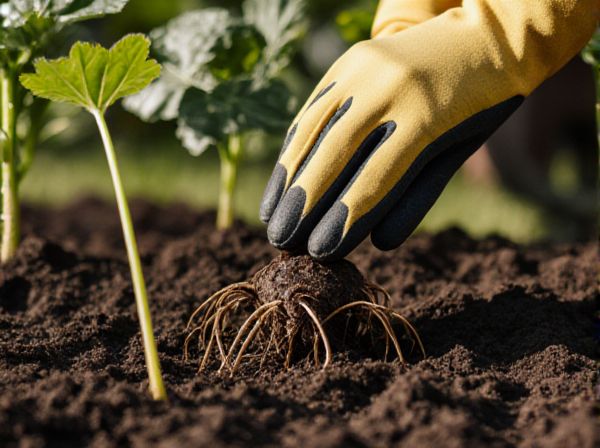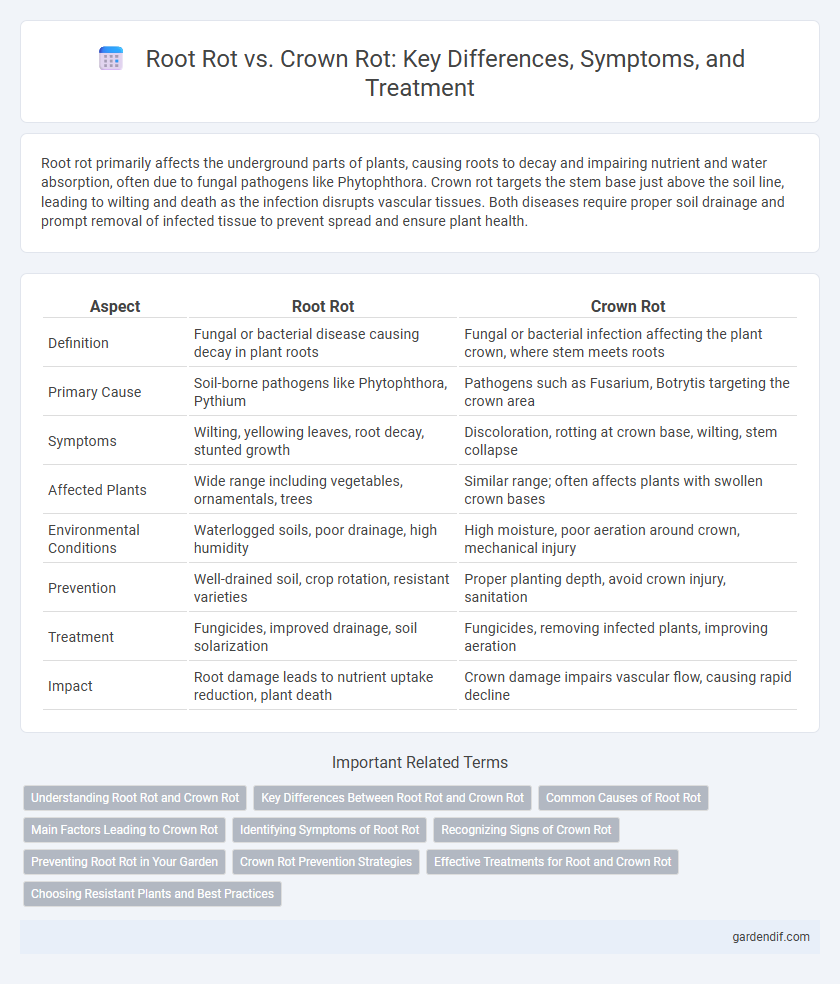
Root Rot vs Crown Rot Illustration
Root rot primarily affects the underground parts of plants, causing roots to decay and impairing nutrient and water absorption, often due to fungal pathogens like Phytophthora. Crown rot targets the stem base just above the soil line, leading to wilting and death as the infection disrupts vascular tissues. Both diseases require proper soil drainage and prompt removal of infected tissue to prevent spread and ensure plant health.
Table of Comparison
| Aspect | Root Rot | Crown Rot |
|---|---|---|
| Definition | Fungal or bacterial disease causing decay in plant roots | Fungal or bacterial infection affecting the plant crown, where stem meets roots |
| Primary Cause | Soil-borne pathogens like Phytophthora, Pythium | Pathogens such as Fusarium, Botrytis targeting the crown area |
| Symptoms | Wilting, yellowing leaves, root decay, stunted growth | Discoloration, rotting at crown base, wilting, stem collapse |
| Affected Plants | Wide range including vegetables, ornamentals, trees | Similar range; often affects plants with swollen crown bases |
| Environmental Conditions | Waterlogged soils, poor drainage, high humidity | High moisture, poor aeration around crown, mechanical injury |
| Prevention | Well-drained soil, crop rotation, resistant varieties | Proper planting depth, avoid crown injury, sanitation |
| Treatment | Fungicides, improved drainage, soil solarization | Fungicides, removing infected plants, improving aeration |
| Impact | Root damage leads to nutrient uptake reduction, plant death | Crown damage impairs vascular flow, causing rapid decline |
Understanding Root Rot and Crown Rot
Root rot and crown rot are fungal diseases that primarily affect the root and crown tissues of plants, causing decay and impaired nutrient uptake. Root rot attacks the root system, often caused by pathogens like Phytophthora or Rhizoctonia, leading to root discoloration, mushiness, and eventual plant decline. Crown rot targets the plant's base near the soil line, characterized by browning, necrosis, and collapse of the crown tissue, frequently resulting from soil-borne pathogens such as Fusarium species.
Key Differences Between Root Rot and Crown Rot
Root rot primarily affects the plant's root system, causing decay and impaired nutrient uptake, while crown rot targets the area where the stem meets the soil, leading to girdling and structural collapse. Root rot is often caused by soil-borne pathogens such as Phytophthora and Pythium species, whereas crown rot typically results from fungal infections like Botrytis and Sclerotinia. The symptoms of root rot include yellowing leaves and stunted growth, whereas crown rot manifests as wilting, stem lesions, and plant toppling.
Common Causes of Root Rot
Root rot primarily results from overwatering, poor soil drainage, and fungal pathogens like Phytophthora and Pythium species that thrive in saturated soil conditions. These fungi invade plant roots, causing decay, reduced nutrient uptake, and eventual plant decline. Distinguishing root rot from crown rot involves identifying the affected area: root rot attacks below the soil line, whereas crown rot impacts the stem base at or above soil level.
Main Factors Leading to Crown Rot
Excessive soil moisture and poor drainage are primary factors leading to crown rot, fostering an environment conducive to fungal pathogens like Phytophthora and Pythium. Poor air circulation around the plant base and wounds or damaged tissues also increase susceptibility to crown rot infections. Soil compaction and high temperatures further exacerbate conditions, promoting the development and spread of crown rot diseases.
Identifying Symptoms of Root Rot
Root rot manifests through symptoms such as stunted growth, yellowing leaves, and wilting despite adequate watering, caused by fungal pathogens attacking the plant's root system. Infected roots appear dark, mushy, and decayed compared to healthy white, firm roots, often emitting a foul odor. Early identification involves inspecting the root zone for these characteristic signs to distinguish root rot from crown rot, which primarily affects the stem base.
Recognizing Signs of Crown Rot
Crown rot primarily affects the base of the plant stem, causing dark, water-soaked lesions and a soft, mushy texture near the soil line. Wilted foliage and stunted growth often accompany these symptoms, indicating the infection's progression. Early detection of crown rot through careful inspection of the crown area is crucial for effective disease management and prevention of plant death.
Preventing Root Rot in Your Garden
Effective prevention of root rot in your garden involves ensuring well-draining soil that prevents waterlogged conditions where pathogens thrive. Regularly inspect plants for early signs of root decay and promptly remove affected roots to stop the spread of fungal infections. Incorporating organic matter like compost improves soil aeration, while avoiding overwatering reduces the risk of soil-borne diseases such as Phytophthora and Pythium species.
Crown Rot Prevention Strategies
Crown rot prevention strategies emphasize proper soil drainage and avoiding excessive irrigation to reduce fungal growth around the plant base. Implementing crop rotation and selecting resistant plant varieties significantly lowers the risk of crown rot infection. Maintaining clean tools and removing infected plant debris further minimizes the spread of crown rot pathogens in agricultural settings.
Effective Treatments for Root and Crown Rot
Effective treatments for root rot and crown rot involve improving soil drainage and applying fungicides such as mefenoxam or phosphorous acid to control Phytophthora and Pythium pathogens. Soil solarization and incorporating organic matter, like compost, enhance microbial activity that suppresses rot-causing fungi. Resistant plant varieties and proper irrigation management are critical preventive measures to reduce the incidence of root and crown rot diseases.
Choosing Resistant Plants and Best Practices
Selecting disease-resistant plant varieties is crucial for preventing root rot and crown rot, as these pathogens thrive in compromised hosts. Implementing best practices such as well-drained soil, proper watering techniques, and crop rotation reduces the risk of infection and promotes healthy root and crown development. Regular monitoring and prompt removal of infected plants further minimize the spread of these soil-borne diseases.
Root Rot vs Crown Rot Infographic

 gardendif.com
gardendif.com